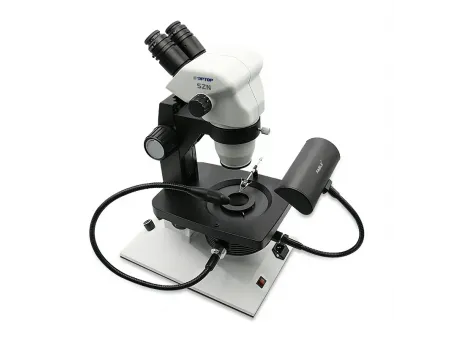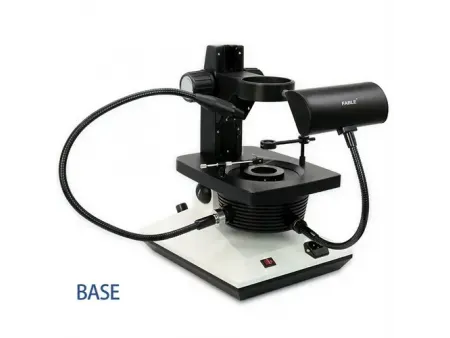Gem Microscope (0-45° Inclined)
Gem microscopes enable detailed examination of inclusions, surface features, and treatments, making it easier to differentiate natural stones from synthetics and identify any enhancements. A magnified view helps professionals assess a gemstone’s quality and authenticity. The R5S/6S series inclined-arm microscopes are stereo zoom models with specialized optics and advanced lighting, delivering sharp, high-contrast imaging. The adjustable tilt design provides flexibility and comfort during extended use, making them a great choice for laboratories, gem trading, and jewelry workshops.
- Lens ×1
- Base ×1
- Eyepiece ×2
- Polarizer (set) ×1
- Conoscopic lens ×1
- Fiber optic tube ×1
- Power cord ×1
- Dust cover
- Optional eyepieces available
The microscope head offers upright, sharp imaging with true-to-life color and a strong sense of depth. Its wide field of view ensures comprehensive observation, while specially coated optical components enhance contrast and maintain image sharpness across the entire visual field. It also features smooth and precise zoom adjustment for detailed analysis.
FGM-R5S/6S-07
- Continuous zoom ratio: 6.7:1
- Objective: 0.67X-4.5X
- Eyepiece: WF15X/16mm
- Magnification: 10X-67.5X
- Interpupillary distance adjustment: 54-76mm
- Diopter adjustment: ±5dp
FGM-R5S/6S-08
- Continuous zoom ratio: 6.7:1
- Objective: 0.67X-4.5X
- Eyepiece: WF15X/16mm
- Magnification: 10X-67.5X
- Interpupillary distance adjustment: 54-76mm
- Diopter adjustment: ±5dp
- Trinocular head compatible with CCD attachment
FGM-R5S/6S-161
- Continuous zoom ratio: 6:1
- Objective: 0.75-4.5X
- Eyepiece: WF10X/22mm
- Magnification: 7.5X-45X
- Interpupillary distance adjustment: 50-75mm
- Diopter adjustment: ±5dp
FGM-R5S/6S-171
- Continuous zoom ratio: 6.7:1
- Objective: 0.75-5.0X
- Eyepiece: WF10X/22mm
- Magnification: 7.5X-50X
- Interpupillary distance adjustment: 48-75mm
- Diopter adjustment: ±5dp
FGM-R5S/6S-171T
- Continuous zoom ratio: 6.7:1
- Objective: 0.75-5.0X
- Eyepiece: WF10X/22mm
- Magnification: 7.5X-50X
- Interpupillary distance adjustment: 48-75mm
- Diopter adjustment: ±5dp
- Trinocular head compatible with CCD attachment.
FGM-R5S/6S-171T-C40
- Continuous zoom ratio: 6.7:1
- Objective: 0.75-5.0X
- Eyepiece: WF10X/22mm
- Magnification: 7.5X-50X
- Interpupillary distance adjustment: 48-75mm
- Diopter adjustment: ±5dp
- Trinocular head compatible with CCD attachment
FGM-R5S/6S-01
- Continuous zoom ratio: 6.3:1
- Objective: 0.63X-4.0X
- Eyepiece: 16X/15mm
- Magnification: 10.0X-64X
- Interpupillary distance adjustment: 54-76mm
- Diopter adjustment: ±5dp
- Equipped with an imported Leica S6E lens
| Illumination | Bottom lighting | 10W high-power, dimmable LED base illumination (imported from the USA), designed for energy efficiency. Features a continuously adjustable aperture (beam diameter: 2-42mm) and a ring-shaped darkfield diffuser with a screw-free mounting system to eliminate unwanted reflections and provide optimal darkfield contrast. |
| Top lighting | 6W ultra-bright LED surface illumination, offering adjustable intensity. The 6500±500K color temperature meets industry standards for diamond grading. | |
| Side lighting | 3W high-intensity adjustable LED side illumination, providing enhanced visibility for fine details. | |
| Base | Classic, stable base with 360° rotation and an adjustable microscope body that tilts freely between 0-45° for flexible viewing. | |
| Ball-bearing focusing guide rail with an adjustable self-locking mechanism for smooth and precise focus control. | ||
| Gem holder mounting slots on both sides for secure specimen placement. | ||
| Integrated crossed polarizing conoscopic system, enhancing gemstone identification under polarized light conditions. | ||
| Power supply | Compatible with 100-240V voltage range, ensuring stable brightness and reliable performance. | |
| Comparison between R5S and R6S | R6S Base with patented illumination system fully separates brightfield and darkfield lighting, eliminating unwanted light interference found in traditional designs. See comparison diagram below for reference:
| |
Gem microscopes help reveal key details about a gemstone’s structure, composition, and any treatments it may have undergone. Examining both surface and internal features provides valuable insights for identification and grading.
- Surface Features
Scratches, etching, fractures, junction lines, twinning patterns, triangular growth marks, and color zoning can indicate whether a gemstone is natural, treated, or synthetic.
- Internal Characteristics
The type, shape, and distribution of inclusions play a crucial role in gemstone identification. Observing growth structures, twinning planes, and internal color patterns can help determine origin and authenticity.
- Interference Patterns
Using crossed polarizing filters with a conoscopic lens enables interference pattern analysis, which helps assess optical properties.
- Pleochroism Analysis
Placing a polarizing filter below the stone and rotating it reveals pleochroic colors. A quick rotation enhances the contrast between different hues.
- Microphotography
A camera attached to the trinocular eyepiece captures high-resolution images of microscopic gem features, useful for research and documentation.




